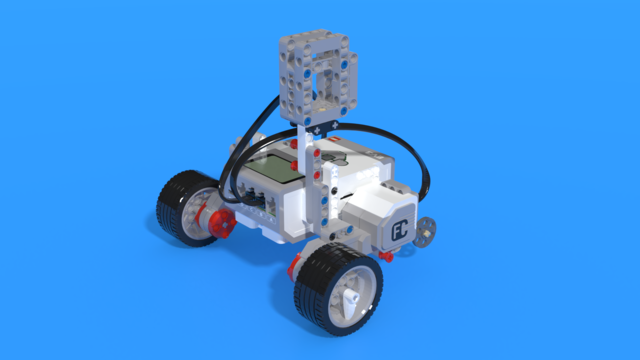
To access the full video please subscribe to FLLCasts.com
- #1522
- 28 Jan 2020
#!/usr/bin/env pybricks-micropython from pybricks.hubs import EV3Brick from pybricks.ev3devices import (Motor, TouchSensor, ColorSensor, InfraredSensor, UltrasonicSensor, GyroSensor) from pybricks.parameters import Port, Stop, Direction, Button, Color from pybricks.tools import wait, StopWatch, DataLog from pybricks.robotics import DriveBase from pybricks.media.ev3dev import SoundFile, ImageFile # This program requires LEGO EV3 MicroPython v2.0 or higher. # Click "Open user guide" on the EV3 extension tab for more information. # Create your objects here. ev3 = EV3Brick() # Write your program here. ev3.speaker.beep()
The entire code between the green lines introduce commands that we can use below them. We will look at them in-depth later on.
The green lines of code are comments that are not executed when the programs start. When we place the "#" symbol at the beginning of a line, everything on that line is considered a comment and is not executed by the program. This allows us to take notes within the code file.
The last line in the code "brick.sound.beep()" is the command for playing a "Beep" sound. We leave it in the program to know when the program has begun executing. You must begin every program you make after the "ev3.speaker.beep()" command.
Courses and lessons with this Tutorial
This Tutorial is used in the following courses and lessons

Python with LEGO Mindstorms EV3 - Level 1
The course introduces students to the programming language Python. We use LEGO Mindstorms EV3 Robots. Python is a popular programming language. It could be used for introducing students to programming, for academic studies, for developing machine learning algorithms and as a general-purpose language.
During the course, students learn how to read and how to develop Python programs. They use an Integrated Development Environment called Visual Studio Code. Robots are programmed to perform interesting and funny tasks like "bringing you water". The level ends with competition on a playing field with boxes.
- 74
- 28:18
- 114

Lesson 1 - Beverage Assistant
Introduction
Anyone who decides to develop themselves in the field of robotics does so because they have been dazzled by the possibilities of automation in everyday life.
Whether you wish to build a multitude of small robots that work together to make your life easier or a big humanoid robot that does your homework for you, you have also come here to create your own robots.
In order to create complex robots, we first need to build simpler ones but this does not mean that they cannot be functional. "Paalia Technology" is one of the companies that began manufacturing and selling robots that are programmed to be waiters and today we will make a simple robot that serves tables today.
For most of us, these are the first steps into robotics, which is why we will start with a simple platter robot that moves to a specific location and returns.
In every lesson, we will learn how to make increasingly more complex robots and you will be able to automate more aspects of your life.

- 14
- 4
- 6
- 3d_rotation 1